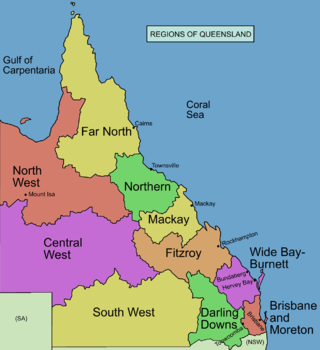
Mornington Island, also known as Kunhanhaa, is an island in the Gulf of Carpentaria in the Shire of Mornington, Queensland, Australia. It is the northernmost and largest of 22 islands that form the Wellesley Islands group. The largest town, Gununa, is in the south-western part of the island.
Doomadgee is a town and a locality in the Aboriginal Shire of Doomadgee, Queensland, Australia. It is a mostly Indigenous community, situated about 140 kilometres (87 mi) from the Northern Territory border, and 93 kilometres (58 mi) west of Burketown.

The Shire of Mornington is a local government area in northwestern Queensland, Australia. The shire covers the Wellesley Islands, which includes Mornington Island; the South Wellesley Islands; Bountiful Islands; and West Wellesley / Forsyth Islands groups in the Gulf of Carpentaria.

Lardil, also spelled Leerdil or Leertil, is a moribund language spoken by the Lardil people on Mornington Island (Kunhanha), in the Wellesley Islands of Queensland in northern Australia. Lardil is unusual among Aboriginal Australian languages in that it features a ceremonial register, called Damin. Damin is regarded by Lardil-speakers as a separate language and has the only phonological system outside Africa to use click consonants.

The Aboriginal Shire of Doomadgee is a special local government area in North West Queensland, Queensland, Australia. It is managed under a Deed of Grant in Trust under the Local Government Act 2004.

The Gulf Country or North West Queensland is the region of woodland and savanna grassland surrounding the Gulf of Carpentaria in north western Queensland and eastern Northern Territory on the north coast of Australia. The region is also called the Gulf Savannah. It contains large reserves of zinc, lead and silver. The Gulf Country is crossed by the Savannah Way highway.

The South Wellesley Islands is an island group and locality in the Gulf of Carpentaria within the Shire of Mornington, Queensland, Australia. The group is separate from the Wellesley Islands.
Dick Roughsey was an Australian Aboriginal artist from the Lardil language group on Mornington Island in the south-eastern Gulf of Carpentaria, Queensland. His tribal name was Goobalathaldin, meaning “the ocean, dancing”, describing a “rough sea”. He was an active and prominent figure involved in reviving and preserving the cultural life of the Lardil people. His best known works are a series of children's picture books that retell traditional Aboriginal stories including “The Rainbow Serpent”.

The Manowar and Rocky Islands Important Bird Area comprise two small islands in the Wellesley Islands group. It lies in the southeastern region of the Gulf of Carpentaria and is part of the state of Queensland, Australia. The two islands are important habitats for breeding seabirds.
Gununa, sometimes spelt Gunana, is a rural town on Mornington Island within the locality of Wellesley Islands in the Shire of Mornington, Queensland, Australia. In the 2016 census, Gununa had a population of 1,136 people.
The Lardil people, who prefer to be known as Kunhanaamendaa, are an Aboriginal Australian people and the traditional custodians of Mornington Island in the Wellesley Islands chain in the Gulf of Carpentaria, Queensland.
The Kaiadilt are an Aboriginal Australian people of the South Wellesley group in the Gulf of Carpentaria, Queensland, Australia. They are native to Bentinck Island, but also made nomadic fishing and hunting forays to both Sweers and Allen Islands. Most Kaiadilt people now live on Mornington Island, although one group has returned to Bentinck Island.

The Cape York Peninsula tropical savanna is a tropical grasslands, savannas, and shrublands ecoregion in northern Australia. It occupies the Cape York Peninsula in Queensland, mainland Australia's northernmost point. It is coterminous with the Cape York Peninsula, an interim Australian bioregion.

The Gulf Plains, an interim Australian bioregion (IBRA), is located in the Northern Territory and Queensland, comprising 22,041,825 hectares. It is one of 89 such bioregions defined in Australia, with 419 subregions as of IBRA version 7, compared with the 85 bioregions and 403 subregions described in IBRA6.1.
The West Wellesley Islands, also referred to as the Forsyth Islands, is an island group and locality in the Gulf of Carpentaria within the Shire of Mornington, Queensland, Australia. The group lies to the south-west of the Wellesley Islands, closer to mainland Australia. The islands were uninhabited as of 2016.
Pains Island is one of the West Wellesley Islands, in Queensland's Gulf of Carpentaria, Australia. it is within the Shire of Mornington. It is located 4.83 km northwest of the mainland, and less than a kilometre north of Bayley Island.
Bayley Island is one of the West Wellesley Islands, on the eastern side of the Gulf of Carpentaria, Queensland, Australia. It is within the Shire of Mornington.

Bentinck Island is one of the South Wellesley Islands, in Queensland's Gulf of Carpentaria. The traditional home of the Kaiadilt people, the island was the site of a brutal massacre in 1918 known as the McKenzie massacre, in which many Indigenous inhabitants died.











